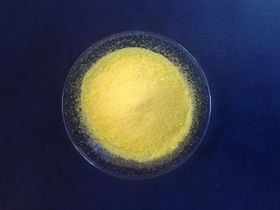Potassium chromate
 Potassium chromate sample on a watchglass.
| |
| Names | |
|---|---|
| IUPAC name
Potassium chromate
| |
| Other names
Chromic acid, dipotassium salt
Dipotassium monochromate Dipotassium chromate | |
| Identifiers | |
| Jmol-3D images | Image |
| |
| Properties | |
| K2CrO4 | |
| Molar mass | 194.19 g/mol |
| Appearance | Yellow solid |
| Odor | Odorless |
| Density | 2.732 g/cm3 |
| Melting point | 968 °C (1,774 °F; 1,241 K) |
| Boiling point | 1,000 °C (1,830 °F; 1,270 K) |
| 56.3 g/100 mL (0 °C) 60.0 g/100 mL (10 °C) 63.7 g/100 mL (20 °C) 67.8 g/100 mL (40 °C) 70.1 g/100 mL (60 °C) 79.2 g/100 mL (100 °C) | |
| Solubility | Soluble in ethylene glycol, trifluoroacetic acid Slightly soluble in acetic anhydride, thionyl chloride Insoluble in alcohols, alkanes, liq. sulfur dioxide |
| Vapor pressure | ~0 |
| Thermochemistry | |
| Std enthalpy of
formation (ΔfH |
-1,383.27 kJ/kmol |
| Hazards | |
| Safety data sheet | ScienceLab |
| Related compounds | |
| Related compounds
|
Potassium dichromate Potassium ferrate |
| Except where otherwise noted, data are given for materials in their standard state (at 25 °C [77 °F], 100 kPa). | |
| Infobox references | |
Potassium chromate (K2CrO4) is the potassium salt of the chromate anion. It is a yellow solid, soluble in water. As a Cr(VI) compound, it is a strong carcinogen and an oxidizer.
Contents
Properties
Chemical
The addition of an acid to an aqueous solution of potassium chromate will yield potassium dichromate.
- 2 K2CrO4 + H2SO4 → K2Cr2O7 + K2SO4 + H2O
Other acids, such as boric acid, hydrochloric acid, nitric acid, glacial acetic acid, oxalic acid, phosphoric acid can also be used. Carbon dioxide also works.
Physical
Potassium chromate is an odorless yellow solid, soluble in water, trifluoroacetic acid, liq. hydrogen cyanide, phosphoryl chloride. It is insoluble in acetone, anhydrous ammonia, aniline, benzonitrile, liq. chlorine, ethyl acetate, methyl acetate, molten antimony(III) chloride, vanadyl chloride (both cold and hot).
It has an average density of 2.7320 g/cm3.
Availability
Potassium chromate is sold by various chemical suppliers. It can also be found on eBay.
Preparation
Potassium chromate can be made by adding potassium hydroxide and conc. hydrogen peroxide or bleach to a suspension of chromium(III) hydroxide.
- Cr(OH)3 + 2 KOH + H2O2 → K2CrO4 + H2O + 3/2 O2[1]
- 2 Cr(OH)3 + 6 KClO → 2 K2CrO4 + 4 KCl + 2 Cl2
The chromium hydroxide can be made by dissolving stainless steel in hydrochloric acid, followed by precipitation with sodium carbonate.[2]
If you're using common bleach, you will end up with sodium chromate. To convert it into potassium chromate, you will need to add a potassium salt, such as potassium carbonate.
Chromium(IV) oxide can also replace chromium(III) hydroxide.[3]
It can also be made by adding potassium hydroxide to potassium dichromate in solution.
Heating potassium dichromate will result in potassium chromate, chromium(III) oxide and oxygen.
- 4 K2Cr2O7 → 4 K2CrO4 + 2 Cr2O3 + 3 O2
Heating a mixture of potassium nitrate and chromium(III) oxide with traces of water will also give potassium chromate.[4] This reaction however does not work with indurated chromium oxide (like the OTC chromium oxide pigment).
Projects
- Make potassium dichromate
- Make chromium trioxide
- Make potassium peroxochromate
Handling
Safety
Potassium chromate, like all hexavalent chromium compounds, is highly toxic and carcinogenic on ingestion or inhalation. Handling it without gloves can cause dermatitis, and can also be absorbed through the skin in small amounts, usually if wet. Aqueous solutions are notorious for staining most materials.
Always wear gloves and goggles when handling it, and a dust mask or respirator when handling it as a powder to avoid inhalation of it, which could be fatal.
Storage
Potassium chromate should be stored in closed bottles, with a visible label.
Disposal
Potassium chromate can be safely reduced to the less harmful Cr(III) oxide with a reducing agent, such as ascorbic acid, or various sulfites/metabisulfites/tiosulfates.
References
- ↑ Martinon; Bulletin de la Societe Chimique de France; vol. 45; (1886); p. 862 - 864
- ↑ https://www.youtube.com/watch?v=F_W-IyUTM5M
- ↑ Martinon; Bulletin de la Societe Chimique de France; vol. 45; (1886); p. 862 - 864
- ↑ Guignet; Bulletin de la Societe Chimique de France; (1859); p. 9 - 11
Relevant Sciencemadness threads
- Chemical pages without CAS Registry Number
- Articles without EBI source
- Chemical pages without ChemSpiderID
- Chemical pages without DrugBank identifier
- Articles without KEGG source
- Articles without InChI source
- Articles without UNII source
- Articles containing unverified chemical infoboxes
- Chemical compounds
- Inorganic compounds
- Potassium compounds
- Chromium compounds
- Chromates
- Oxidizing agents
- Materials unstable in acidic solution
- Carcinogenic